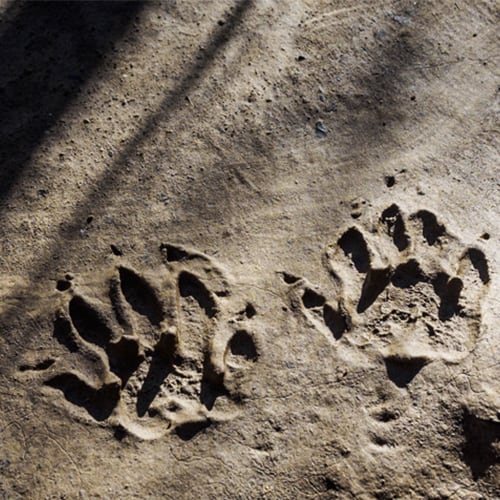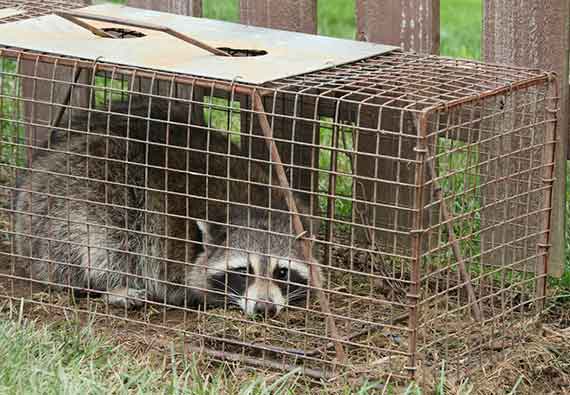Identify

Wind gusts or a top-heavy bin falling over may not be the rustling noises you hear near your garbage cans at night.
A fuzzy visitant may have discovered your yard as a favorite eating spot. Raccoons may seem delightful, but they pose a danger to homeowners and farmers, as well as being a vector of illness. If you see a raccoon near your home, it’s essential to comprehend what they’re doing and how to avoid them.
Physical Characteristics
Ants are thought to have over 10,000 different species, with just a few breeds routinely venturing indoors, according to researchers. The most prevalent home invaders, as well as the hazards they pose, are listed below:

- Adults may weigh from 10-30 pounds and measure two to three feet long (tail included)
- Distinctive blackened areas around the eyes
- Grizzled-gray fur with a bushy tail that features dark rings
- Eats both plants and animals
- May run up to 15 miles per hour and also swims
- Found throughout most of the U.S.
- Less active in winter, but do not hibernate
- More active at nighttime as they seek out sources of food
Life Cycle

Raccoons only live three to five years in the vast majority of cases, despite their seasons-based activities. Animals under a year old make up approximately 50-70% of their populations. Their presence in the food chain helps to keep populations in check.
A Raccoon’s Life Cycle Moves as Follows:
- The spring months see the birth of a new generation of raccoons after a gestation period of about 63 days. Most new groups consist of one to four babies, called kits. The young stay with the mother for six to ten months.
- The youngest raccoons are weaned during late summer and fall, at which point many will leave home to build their own dens.
- As they reach adulthood, raccoons will roam about during winter and early spring in search of mates. Males (called boars) are known to travel greater distances than females (called sows) during breeding season as mating occurs only once per year.
Pro Tips
- Raccoon tracks may be confused with opossum tracks.
- They walk flat-footed (like humans) and have claws on all toes.
- The name “raccoon” is inspired by the Algonquin Native American term for “one who scratches with his hands.”
Risks
Can Raccoons Transmit Disease?
Raccoons can transmit a limited number of serious illnesses to humans, the most dangerous of which is a deadly strain of rabies that spreads fast. Fleas, ticks, and lice can be carried by their bodies as well.
A roundword egg called Baylisacaris procyonis may be found in raccoon droppings, and it can transmit a dangerous illness to human youngsters. The roundworm’s larvae may reach the child’s eyes or brain if a youngster comes into touch with raccoon feces holding the egg. They may cause blindness or even death.

Why Is a Raccoon on My Property?
The types of food raccoons eat, the environment they live in, and the presence of people are all irrelevant to them. These animals are adaptable and will eat in any environment that suits their needs. They are opportunistic in nature. Explain why this is the case in your own home.
- In cities and suburbs, raccoons have learned to live and feed in homes and buildings by adapting. They enter homes and establish a den in attics by living inside chimneys and raking through siding and shingles. The openings above your ceiling may be reached from tree limbs that stretch close to your roof. Raccoons prefer natural shelters like hollow trees, rock cracks, brushy areas, and abandoned animal burrows in rural regions. They may also build a residence near a water source.
- Raccoons have a home wherever they go. Because of the abundance of trees, they are a common sight near farms and woodlands. Raccoons, on the other hand, are found across practically every corner of the United States. These animals are only seen on very high mountains and in arid areas of the world.
Inspect

Signs of Damage
Here are some raccoon activity clues:

- A raccoon is likely to be the perpetrator if your trash bins have been regularly knocked over and rummaged through. They have nearly as nimble front paws as a human, allowing them to open a variety of objects with ease. It’s vital to secure the lids on your trash cans because leftover food and debris are a powerful entice. To deter your nighttime visitors, you may need bungee cords or pest-proof lids.
- Raccoons can be a surprise for pool owners since they leave their droppings in the water on the top steps of the shallow end. This is a way for an animal to hide its smell from nearby predators. A simple way to push a raccoon away is to cover the top steps with plastic.
- Outdoor meal bowls and bird feeders should be monitored by dog owners and birdwatchers. When a food source appears to be regularly replenished, a raccoon will attack it. During the day, feed your pet and clean his dish before darkness falls.
- To make a home in your attic, a determined raccoon might claw through shingles or fascia boards. Claw marks and a big enough aperture for a little creature to enter may be visible in these regions. A raccoon might rip open insulation and damage ductwork once it gets inside. Stuff newspaper into the entry hole you’ve discovered to see if your residence has been breached. A raccoon or another tiny creature is most likely to blame if the newspaper has been ripped out in a few days.
What Are The Sounds and Signs Of Raccoons?

Tracks may be used to determine if a raccoon is visiting your home. Being small mammals, their own paw prints have a particular pattern that distinguishes them from others.
The hind print is considerably longer than broad, measuring 3 ¼” to 4 ½” long. With a comparable width, the fore print is merely about 3 inches long. The walking movement will be indicated by a distance of roughly a foot between the fore and hind prints. Skunk tracks are half the width of these tracks.
Apart for the rustling caused by a raccoon’s activity, homeowners are unlikely to hear many noises from them. One exception is when one raccoon whistles like an owl, which is a sound made by calling out to another.
Where to Find Them
Depending on where you live, the answer will be different. A raccoon will be comfortable with humans in an urban or suburban environment, and it will seek to construct a den inside a house or structure. Dens may be found in attics, chimneys, underneath decks, and other locations inside or beneath a residence, as previously indicated. In reality, multiple dens are possible in a raccoon’s home range.
A raccoon will create its den in natural shelters like hollow trees, alleys between enormous boulders, and stands of encroached brush if you live in a more rural or sparsely populated region. Raccoons are nocturnal animals, and thus will seldom be seen during the day.
Seasonal Behavior

Although raccoons do not hibernate and are by nature solitary, their activity varies with the seasons. What does this mean for homeowner?
- Raccoons will seldom venture out of their dens during the harshest winter days because they’re trying to sleep through the cold. At the same time, the breeding season starts. Because of the low temperatures in northern states, raccoon activity may go unnoticed. A raccoon’s daily life in southern states with mild winters may be mostly unaffected.
- Spring sees new populations of raccoons as sows give birth.
- Kits are weaned during summer and moved about to prepare them for life on their own.
- Young raccoons sense autumn and will start to leave their dens to find a new place to live.
- Because of their position in the food chain, full-grown adult raccoons generally survive three to five years in most populations.
Prevent

1. Seal Off Your Home and Yard

It’s best to try to prevent raccoons from entering your garden or attic in the first place, so dealing with them there might be a nightmare. Physical barriers may eliminate convenient access points around your whole property or particular regions.
- There are seals in the holes. If they can smell and easily reach their next meal, raccoons have a strong sense of smell that they employ to discover food. They won’t hesitate to enter your dwelling if they can. Any holes you discover around your house’s siding, basement, or roof should be sealed. A raccoon may scratch open any hole that is three inches broad or bigger, allowing them to enter easily. Wood, caulk, expandable foam, and concrete are all options for sealing these holes yourself.
- A perimeter fence is the best option. Raccoons are excellent climbers who frequently explore trees and high places. If a raccoon is dead set on getting into your trash or pet food, a privacy fence surrounding your yard may not be enough to keep it out. Baby raccoons can squeezing through any openings or flaws that are as tiny as three inches, and these pests may simply climb fences in seconds. An electric fence is the only certain method to keep raccoons out. This long-term solution to keep raccoons and other animals out is a fantastic investment. You may try to keep your trees and shrubs cut away from a typical wood or metal privacy fence in order to make it less convenient to climb.
- Barrier screens are a good idea. There are a number of intentional openings on the exterior of your house that you may not consider raccoon entrances. These might encompass your crawl space access, your chimney entrance, and any side vents in your home that aid with ventilation. Cover these apertures with a barrier screen. Simple materials like mesh or screen, as well as nail plywood over crawlspace openings, may be used to keep flies out.
- Raccoons may be repelled using barriers around your yard or specific plants. This is a cost-effective way to preserve your plants. Wrap a perimeter around your plants with a mesh screen that you simply purchase. Make sure to dig the raccoons out by digging the screen sufficiently into the earth.
Scare Tactics

- Raccoons are still prey at the end of the day, despite their intelligence and annoying nature. They won’t hesitate to approach a residence or human, but if they sense danger, they’ll flee quickly. To keep them away from your yard, you may employ a variety of frightful tactics. They may, however, be drawn to your yard and forget about the possible hazards or learn how to avoid them. You may need to modify the tactics you employ to keep raccoons guessing. In order to permanently rid raccoons, this technique should be used in conjunction with other treatments.
- You can scare a raccoon away with a speaker, blow horn, or even your own voice if you’re home and see one approaching through a window.
- Raccoons have been known to fight with cats and small dogs. You can, however, bring your big dog outside to confront the raccoon and scare it away.
Treat

Their striped tails, pointed ears, and dark, mask-like coloring around their eyes make them easily identifiable as cats or small dogs. They’d be considered adorable if they weren’t such harmful pests, with their tiny, fingerlike hands and capacity to walk on their hind legs.
Raccoons are often spotted rummaging through garbage and leaving waste all around. While hunting for food, they are clever foragers, but they may also get into fights with other outdoor creatures.
Treatment Methods
Raccoons, like any other trash-digging pests, wreak havoc in the same way. Raccoons, on the other hand, can enter basements and attics, unlike opossums or skunks. Look for raccoons’ distinct five-finger paw prints to determine if they are the perpetrator if you notice trash scattered around your yard and your outdoor garbage cans have been damaged.
You might hear scratching sounds at night if there are raccoons in your attic while they’re awake and hunting for food. This pest isn’t difficult to catch in the act, despite its reputation for being shy.
1. Remove Attractants

Any attempts to shoo raccoons away can be futile unless you address the source of their attraction to your land in the first place. The first thing you should do is make your property less appealing to them, so they will stop coming back.
- Seal trash properly and dispose of it properly. Seal the trash cans correctly without leakage or cracks, and make sure they are never overflowing. Consider buying a lock or some form of tie-down for your trash can lid, such as bungee cords, because raccoons have been known to open trash cans on their own. Always tidy up any trash promptly and never leave food sitting out if you eat or entertain outside.
- Store it in a covered or enclosed container. Raccoons will be drawn to your pets or bird feeders, too. While raccoons are active, try not to leave pet meals out at night, and likewise purchase covers for your bird feeders. You may need to install preventative barriers like fences if you also have a garden or small fish pond in your back yard. A raccoon will fish for food and devour the greenery in your yard if it is hungry enough.
2. Sanitation

A raccoon’s keen sense of smell can alert it to odors both inside and out of your home, no matter whether you leave food or trash outside. Raccoons may be repelled from your home and prevented from scavenging by using proper sanitation techniques.
- Garbage cans are cleaned on a regular basis. One of the filthiest items in any home is undoubtedly trash bins. Any residue remaining inside them is likely to give off a foul stench, even if they are closed and sealed properly. If you know something has spilled inside one of your cans, be sure to wash it out with soap and water on a regular basis.
- Collecting leaves to rake up. If raccoons are allowed to rot and emit a strong stench, they will be even more drawn to fruiting trees or veggies in your yard. When feasible, pick up any fruit that falls to the ground and try to do so as often as possible once they are ripe.
3. Trapping

If raccoons aren’t able to locate much food on your property, they’ll most likely move on. But if they continue to visit or you discover that you have some nesting inside your attic, basement, or crawl spaces, examine trapping solutions. Raccoons may be removed using cage traps, but you’ll have to take additional steps to make sure they don’t return.
How To Use A Raccoon Trap
- Research your state’s rules or particular raccoon trap restrictions before purchasing and utilizing one. You might need a license or be restricted to trapping and releasing raccoons in a specific manner.
- Fully read the instructions that come with any trap you’ve purchased. Most raccoon traps work with one-way doors, but others can have mechanical spring mechanisms that may be dangerous to set up if you aren’t sure exactly how to do it properly.
- If you’ve been able to identify the raccoons’ nest on your property, place the trap in an area where you’ve seen raccoons feeding or near their nest.
- Since raccoons adore to eat practically anything, bait the trap with whatever you have on hand. You can feed your pet anything from fish to nuts and fruit.
- Make sure you check the trap every morning to see if you’ve caught a raccoon. It might get injured attempting to escape or dehydrate and die if you leave it for too long.
Pro Tips
- Place a raccoon’s stress-relieving ball or pet toy inside the live trap to keep it from becoming stressed. If it tries to get away from the trap, it might harm itself.
- Contact a professional immediately to assist remove the raccoon from your property if it is making unusual noises, appears more aggressive, or lethargic. Rabies might be the cause of these symptoms, which would be especially harmful for anyone who gets bitten.
DIY Treatment Methods

Since raccoon repellent is not advised as a single remedy strategy, it’s essential to keep them out of your property until the repellent has worn off. When used in conjunction with other treatment and prevention methods, there are several DIY repellent techniques that may assist make your property less appealing to them:
- Raccoons don’t like hot peppers and don’t want them anywhere near their supper, unlike humans who can tolerate them. You may keep these animals away from your trash or garden by coating hot peppers in water and spraying this solution strategically. You may apply the spray on your plants straight from this approach, which is 100% natural.
- Spices: Black pepper, cayenne pepper, and cinnamon are just a few spices that raccoons avoid for the same reason that they avoid peppers. Sprinkle these natural raccoon deterrents liberally around the places where you want to keep them away.
- Raccoons have natural predators, just like other animals, to keep them away from their pets and predators’ urine. The sight of dogs and cats will discourage raccoons, since they are two of the animals that raccoons fight. Yet, if your animals get into a combat with a raccoon, they may be in danger, so it is best to keep them indoors and out of danger’s way. Raccoons will stay away from your trash and gardens if you dumping their fur or urine around it.
When To Call a Prefesional

It may be beneficial to contact a wildlife removal professional since raccoons are smarter and larger than other typical pests, such as mice or flies. This expert can tell faster than you if the pest is a raccoon or another species, and he’ll spend time inspecting your property. As part of a preventative measure, your professional may assist you clean up some of the raccoon damage. The expert’s removal strategy will most likely be used in conjunction with rehabilitation, habitat alteration, removal, and prevention to increase success rates. In addition, many wildlife removal companies offer money-back or satisfaction guarantees, in which the experts will continue to try different ways until the problem is completely resolved or they return your money if they aren’t.